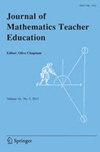小学数学专家认证、知识、信念与课堂学习环境的关系
IF 2.1
2区 教育学
Q1 EDUCATION & EDUCATIONAL RESEARCH
引用次数: 0
摘要
摘要:本研究报告了28名小学数学专家(EMSs)和33名其他教师(EMSs)在课堂上的数学学习环境的差异。我们使用路径分析来检验诸如教学的数学知识、信念和背景特征等变量如何与学习环境相关。我们使用了课堂学习环境测量(CLEM)观察协议,该协议关注数学课程的各个方面,如学生证明其推理和关注数学概念的机会。我们的分析显示,包含这些因素的学习环境在EMS授课的班级中更为普遍,并且有两条路径表明EMS状态与学习环境之间的中介作用。一条路径与教师关于计算在数学学习中的首要地位的信念有关;另一条路径与教师的数学教学知识以及他们对学习者构建数学知识的程度的信念有关。我们分享了EMS计划的启示,以及对未来小学EMS影响研究的建议。本文章由计算机程序翻译,如有差异,请以英文原文为准。

Relationships between elementary mathematics specialist certification, knowledge, beliefs, and classroom learning environments
Abstract We report on the differences in mathematics learning environments in classes taught by certified Elementary Math Specialists (EMSs) ( n = 28) and their peers ( n = 33) as determined by observations of instruction. We used path analysis to examine how variables such as mathematical knowledge for teaching, beliefs, and background characteristics were related to the learning environment. We used the Classroom Learning Environment Measure (CLEM) observation protocol, which attends to aspects of mathematics lessons such as opportunities for students to justify their reasoning and attend to mathematical concepts. Our analysis revealed that learning environments incorporating such elements were significantly more prevalent in classes taught by EMSs, and that there were two paths indicating mediation effects on the relationship between EMS status and learning environment. One path was related to teachers’ beliefs about the primacy of computation in learning mathematics; the other path was related to teachers’ mathematical knowledge for teaching and their beliefs about the extent to which mathematical knowledge is constructed by the learner. We share implications for EMS programs and recommendations for future research on the impact of EMSs in elementary schools.
求助全文
通过发布文献求助,成功后即可免费获取论文全文。
去求助
来源期刊

Journal of Mathematics Teacher Education
EDUCATION & EDUCATIONAL RESEARCH-
CiteScore
5.40
自引率
9.50%
发文量
35
期刊介绍:
The Journal of Mathematics Teacher Education (JMTE) is devoted to research into the education of mathematics teachers and development of teaching that promotes students'' successful learning of mathematics. JMTE focuses on all stages of professional development of mathematics teachers and teacher-educators and serves as a forum for considering institutional, societal and cultural influences that impact on teachers'' learning, and ultimately that of their students. Critical analyses of particular programmes, development initiatives, technology, assessment, teaching diverse populations and policy matters, as these topics relate to the main focuses of the journal, are welcome. All papers are rigorously refereed.
Papers may be submitted to one of three sections of JMTE as follows: Research papers: these papers should reflect the main focuses of the journal identified above and should be of more than local or national interest.
Mathematics Teacher Education Around the World: these papers focus on programmes and issues of national significance that could be of wider interest or influence.
Reader Commentary: these are short contributions; for example, offering a response to a paper published in JMTE or developing a theoretical idea. Authors should state clearly the section to which they are submitting a paper. As general guidance, papers should not normally exceed the following word lengths: (1) 10,000 words; (2) 5,000 words; (3) 3,000 words. Maximum word lengths exclude references, figures, appendices, etc.
Critiques of reports or books that relate to the main focuses of JMTE appear as appropriate.
 求助内容:
求助内容: 应助结果提醒方式:
应助结果提醒方式:


